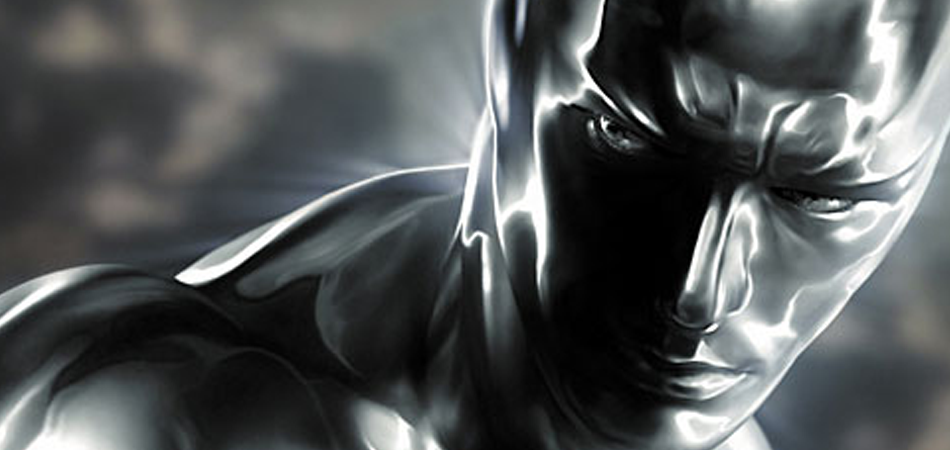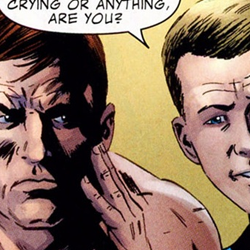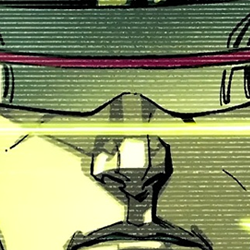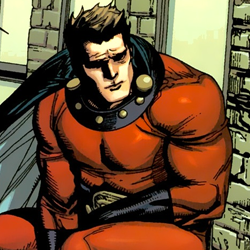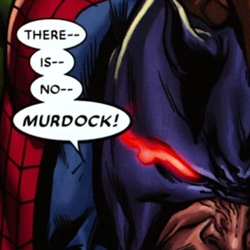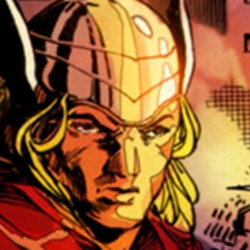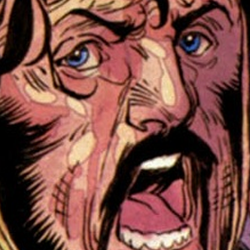Guide to Marvel Cosmic, Part 1: The Characters
With the completion of The Thanos Imperative and the coming release of the one-shot epilogue, The Thanos Imperative: Devastation, Marvel is bringing a close to several years of epic storytelling in their Marvel Cosmic line of comics. Envisioned and given life by Marvel heavyweights like Stan Lee, Jack Kirby, Jim Shooter and Jim Starlin, the Marvel Cosmic setting reached its height of popularity in the 70s and 80s. While the characters would continue their grand adventures over the years, the setting wouldn’t see major success again until it was revitalized in 2005’s “Annihilation” event. Since then, the Cosmic comics have been delivering some of Marvel’s best writing and its most consistently high-quality stories. For the last few years, and especially since the start of The Thanos Imperative, I’ve been recommending these comics to everyone. However, due to the relative obscurity of many of these characters as opposed to Spider-Man or Captain America, it’s hard for many to get into these stories. So, I present to you my Guide to Marvel Cosmic, beginning with the Characters. When first examining the Marvel Cosmic setting, the first thing to look at is the three empires constantly at war over territory; the Kree, the Skrulls and the Shi’ar. The Kree The Kree are a human-like race, known for their incredible intelligence and advanced technology. Initially discovered by the Skrulls, the Kree were deemed unworthy and lashed out, killing many and stealing their technology. Before long, the Kree had reverse-engineered interstellar travel and started an all-out war between the two races, lasting hundreds of thousands of years, never reaching a resolution. During this war, Earth would be a major factor, as our solar system lies directly between the two empires. The driving force of Kree culture is their attempts at advancing genetically, as their own evolution had halted, even conducting genetic experiments on early humans. They attempted cross-breeding with other races, leading the traditionally blue-skinned species to turn pink, making them essentially indistinguishable from humans. Supreme Intelligence: An organic computer created from the Kree’s greatest minds, the Supreme Intelligence was originally created to advise the Kree and help them in their war with the Skrulls. Eventually, the Supreme Intelligence would gain its own personality and become the ruler of the Kree, even worshipped as a god by many. Seemingly killed by a group of Avengers, the Supreme Intelligence has managed to survive in one form or another for years, but never regain its power. Ronan the Accuser: As a member of the Kree’s blue-skinned nobility and one of their most powerful warriors, Ronan quickly rose through the ranks of the Kree Public Accuser Corps, becoming Supreme Accuser. As Supreme Accuser, Ronan was responsible for upholding the law across the breadth of the Kree Empire, second in power only to the Supreme Intelligence. Recently, Ronan has been central to the reformation of Kree society, acting as their leader for a time. Captain Marvel: Mar-Vell was a young Kree hero, selected for a mission to Earth, though he was an unwitting pawn of both Ronan and the Supreme Intelligence. Mar-Vell became one of Earth’s greatest heroes, even forming a bond with long-time Avengers sidekick Rick Jones. Time and time again, Mar-Vell would defy orders, fighting the Kree on behalf of Earth, thwarting their plans. Mar-Vell died of cancer, surrounded by his friends and allies, as one of the greatest heroes the universe has ever known. The Inhumans: Thousands of years ago, in one of their many genetic experiments, the Kree created the Inhumans on Earth by exposing early humans to a substance known as the Terrigen Mists. The Mists caused genetic abnormalities, leading to extraordinary powers. Though the Inhumans would interact with many Earth heroes, most notably the Fantastic Four, they spent most of their existence in seclusion from the rest of the world. The Inhumans are led by their king, Black Bolt, whose voice is so powerful merely uttering a single word can destroy an entire city. After the Secret Invasion tore their society apart, the Inhumans left Earth to return to the Kree, even managing to take control of the empire. The Skrulls The Skrulls’ defining traits are their green skin, pointy ears and their ability to shapeshift. A race of warriors, the Skrulls rapidly increased the size of their influence, building one of the largest empires in the galaxy. While the Kree saw Earth as a way to enhance their genetics, to the Skrulls it was just another planet to conquer. The fact that it was valued by the Kree only increased the Skrulls desire to conquer it. When one of their early invasion attempts ended with Reed Richards convincing the Skrulls to shapeshift into cows and then hypnotizing them to believe they actually were cows, the Skrulls’ desire to conquer the planet grew exponentially. For years to come, the Skrulls would replace key members of Earth’s governments and superhero teams, waiting for the perfect time to strike. With the Skrull empire almost completely destroyed, they launched their “Secret Invasion,” attempting to claim Earth as their new homeworld. The Skrulls were defeated, leaving only small remnants of their race spread across the galaxy. Super-Skrull: Kl’rt was a Skrull warrior selected for a special project; he was imbued with the powers of each member of the Fantastic Four. Over the years, Super-Skrull would repeatedly clash with the Fantastic Four and later, as an agent of Thanos, Captain Marvel. More recently, Kl’rt sacrificed himself in an attempt to save the Skrull empire from the Annihilation Wave. He was later resurrected with a new outlook on life, helping Ronan liberate the Kree and even fighting against the Skrulls in the Secret Invasion. Paibok: Paibok the Power Skrull was another frequent enemy of the Fantasic Four, though never gaining the notoriety Super-Skrull did. During the Annihilation Wave, Paibok was mind controlled and forced to fight for the destruction of the galaxy, even against his fellow Skrulls. Queen Veranke: With the Skrull empire devastated, Veranke rose to power over the remnants of her race. A religious extremist, Veranke was convinced that it was the Skrulls’ divine right to claim Earth as their new homeworld. She knew of the plan to replace Earth’s heroes with Skrulls and led the Secret Invasion. At the end of the battle, she was killed by Norman Osborn. The Shi’ar The Shi’ar are a bird-like race of humanoids with the largest known empire in the galaxy. The Shi’ar are most known for their interactions with the X-Men, both as enemies and allies. They serve more as a force of order in the galaxy, attempting to contain the likes of the Phoenix Force and even Galactus. Much conflict for the Shi’ar is not with other races, but rather within; there are constant power struggles and civil wars, frequently drawing in the X-Men and other heroes. The largest of these struggles was when Vulcan, Gabriel Summers, attacked the Shi’ar, wanting revenge for the death of his mother, overthrowing the government and declaring himself emperor. The former empress, Lilandra teamed up with a group of X-Men and the remaining crew of the Starjammer to lead the rebellion. Both Lilandra and Vulcan were killed, leaving Gladiator, the head of the Imperial guard as the new leader of the Shi’ar. D’Ken Neramani: As the long-time emperor of the Shi’ar Empire, D’ken was a brutal dictator. Growing increasingly unstable, D’Ken attempted to use the power of the legendary M’Kraan Crystal to gain absolute power. He was defeated by the combined efforts of his sister, Lilandra, the X-Men and the Starjammers. Lilandra Neramani: D’Ken’s younger sister, Lilandra, knew her brother needed to be stopped before he destroyed the universe. She travelled to Earth, enlisting the aid of Professor X and the X-Men. She ruled the Shi’ar Empire in relative peace for years after, until she was deposed by a returned D’Ken. Deathbird: Lilandra and D’Ken’s older sister Cal’syee was determined, too bloodthirsty to rule the Shi’ar and was exiled before she could take the throne. She was a constant threat to both Earth and the Shi’ar before she married Vulcan to help cement his rule. Vulcan: Gabriel Summers, the long-lost third Summers brother was long thought dead, even his existence unknown to all but Professor X. When he was discovered alive, he left Earth for the Shi’ar Empire to exact revenge for the murder of his mother. Vulcan allied himself with D’Ken after he had reclaimed the throne from Lilandra and married Deathbird. He eventually turned on D’Ken, killing him and becoming the new emperor. The Imperial Guard: The elite forces of the Shi’ar, the Imperial Guard is made up of the strongest fighters from across the empire. They are loyal to the throne, and will fight for the leader of the Shi’ar, regardless of right or wrong. For years, the Imperial Guard has been commanded by Gladiator, one of the strongest fighters in the known universe. The Starjammers: After their abduction and the murder of his wife, Christopher Summers, father of Cyclops, Havok and Vulcan, took the name Corsair and led the crew of the Starjammer in a rebellion against D’Ken. When D’Ken rose to power the second time, Corsair was killed, with Havok and his fellow X-Men Polaris and Marvel Girl taking over leadership of the Starjammers. While the three empires may be the largest and most influential members of the Marvel Cosmic line, they’ve by no means the only ones worth talking about. Next we’re going to look at some of the heroes attempting to maintain peace and order in the war-torn galaxy. The Guardians of the Galaxy The original Guardians of the Galaxy were a team of superheroes in the 31st Century. They fought to protect Earth from the threats it would face 1000 years in the future. They would occasionally travel back in time, even becoming honorary Avengers before being lost in a space/time rift. The latest version of the Guardians was formed after the Phalanx attack in Annihilation: Conquest. Star Lord brought together the heroes who had fought the Phalanx, citing a need to prevent any future problems. They established a base of operations in Knowhere, a bizarre space station constructed in the head of a dead Celestial. Star Lord: Peter Quill was granted the mantle of Star Lord to serve as a sort of intergalactic cop, righting wrongs and generally doing good. Star Lord was an obscure character until he was freed from a prison by nova during the Annihilation Wave. While he has no powers beyond those of a normal human, his leadership abilities proved vital in the coming battles. Drax the Destroyer: Drax was a being created for a sole purpose; to kill Thanos. He assisted the Avengers in that goal years ago and wandered the galaxy, lost without purpose, for many years. Freed from the same prison as Star Lord during the Annihilation Wave, he helped Nova and the others once he found out Thanos was involved. Later, after being freed by the mind control of the Phalanx, Drax stayed on as a member of the Guardians, lending them his immense power Gamora: “The Most Dangerous Woman in the Universe” was once a pawn of Thanos, before she turned on him and allied herself with Adam Warlock. She was drawn into battle against the Annihilation Wave, and much like Drax, joined the Guardians after being freed by the Phalanx. Rocket Raccoon: A badass raccoon with a big ass gun. Rocket’s backstory is about as goofy as it gets. All you need to know is he was assigned to Star lord’s team by the Kree to combat the Phalanx, serving as a tactician. Groot: He’s an incredibly strong, sentient tree than can regenerate his body from almost nothing. A powerful fighter, he is good friends with Rocket Raccoon and was also assigned to Star Lord’s team by the Kree. Bug: A master thief, Bug joined Rocket Raccoon and Groot as prisoners selected for Star Lord’s assault team. Mantis: This former Avenger is a powerful telepath. She foresaw the coming of the Annihilation Wave and made her way to space to help, often putting herself in the line of fire to protect her teammates. When the Guardians were formed, she used her telepathy to influence some of the members into joining. Major Victory: Vance Astrovik was one of the original Guardians of the Galaxy. When Star Lord’s team discovered him on an asteroid which had emerged from a space/time rift, he was disoriented and shouted a rallying cry for the “Guardians of the Galaxy.” The fledgling team had a name and a new member. In the 31st Century, Vance obtained Captain America’s shield, which he still uses. Jack Flag: A former protege of Captain America, Jack was paralyzed resisting the Superhuman Registration Act and thrown into the Negative Zone prison, 42. When the staff evacuated during an attack, Jack took over as warden, attempting to keep the prisoners under control. He was rescued by Star Lord and healed on Knowhere. He decided to stay with the Guardians, as he was still a wanted fugitive on Earth. Cosmo: Cosmo was a dog used during the Soviet Union’s space experiments in the 1960s. His rocket went off course, somehow finding its way to Knowhere. Cosmo gained telepathic communication due to a mutation and has served as Knowhere’s Chief of Security ever since. Nova There have been two major Marvel characters to go by the name of Nova. The first is the former love interest of the Human Torch and Herald of Galactus, the other is who we’re focusing on here, the hero known as Richard Rider. Nova is basically Marvel’s version of the Green Lantern in concept. The Nova Corps are the police force protecting the entire Marvel Universe. For much of his superhero career, Rich alternated between helping the Nova Corps out in space and fighting with the Earth team of young heroes, the New Warriors. When the Annihilation Wave hit, its first target was the Nova Corps and their base of operations on New Xandar. Rich was the only Nova Centurion left alive in the entire galaxy, and he now possessed the Nova Corps Worldmind. In order to preserve itself and the Corps, the Worldmind downloaded itself into Rich’s Nova helmet, granting him access to all the combined knowledge and power of the entire Corps. Supercharged, Nova became the front line of defence in the many crises to follow and has begun to rebuild the Corps. Adam Warlock Adam Warlock was created to be the perfect human being, the height of human potential, though he has the potential for great good or great evil. In one of his early adventures, Warlock encountered an insane future version of himself gone mad with power, known as Adam Magus. Knowing what may lie in store for him, Warlock sought to do some good in the universe, constantly clashing with Thanos. During the Annihilation Wave, Warlock’s Cosmic Awareness caused him to feel each of the billions of deaths, nearly driving him insane. A partially recovered, but still unstable Warlock would assist in the defeat of the Phalanx and briefly joining the Guardians of the Galaxy. He used his Cosmic Awareness to guide the team in attempting to repair the universe, but would not remain long. Once Mantis’s mental influence over the team was discovered, many members, including Warlock would leave, though he would return soon… as Magus. Quasar Wendell Vaughn was a guard at a Stark Labs facility investigating the cosmic artifacts known as the Quantum Bands. During an attack, he put the bands on and was able to harness their power. As Quasar, Wendell was named Protector of the Universe, the successor to Captain Marvel. He would fill that role admirably until his death during the Annihilation Wave. The Quantum Bands would pass to Phyla-Vell, Captain Marvel’s daughter, making her the new Quasar. Phyla-Vell did her best, but was killed when Thanos returned to life prior to The Thanos Imperative. Wendell was later reborn as a being of pure energy and reclaimed the Bands. Beta Ray Bill Beta Ray Bill was chosen as the champion of a dying race, the Korbinites. He was given a cybernetic body in order to protect them and guide them to their new home. During their journey, their ship flew close to Earth and Thor was sent to investigate. Bill defeated Thor in battle, even proving worthy enough to wield Mjolnir. Bill later proved his worthiness by defeating Thor once again in a battle designed by Odin to teach Thor humility. In recognition of Bill’s worthiness, Odin commissioned a weapon for Bill, Stormbreaker, equal in every way to Mjolnir. Bill would spend the next years battling foes both cosmic and Asgardian, even confronting Galactus on more than one occasion. Silver Surfer Norrin Radd lived a peaceful life on the planet Zenn-La until the day Galactus arrived to consume their world. Norrin offered to become Galactus’s Herald in exchange for sparing his planet. As Herald, Norrin would seek out worlds fit for Galactus to consume, but free of sentient life. Galactus accepted the offer and transformed Norrin into the cosmically-powered Silver Surfer. Over time, Galactus’s hunger eclipsed his will and he altered the Surfer’s mind, causing the Surfer to lead him to inhabited worlds and, in time, Earth. Though the Surfer turned on Galactus to protect Earth and spent years fighting evil on his own, he would return to Galactus’s service in order to combat the Annihilation Wave. Of course, heroes would be nothing without threats to combat. On Earth, villains want to rob banks, blow up buildings and conquer small countries. Not content with such simple goals, cosmic villains just want to end all life in the universe. They’re a badass bunch, and it’s understandable that it would take an assembly of all the heroes above to take down just one of them. Galactus The Devourer of Worlds is a being of almost unimaginable power. Unfortunately, all that power must be fed, hence the title. In order to sustain himself, Galactus breaks down suitable planets into their base energy and consumes them. Aided by the Silver Surfer and his other Heralds, Galactus constantly seeks out new worlds to devour, as his hunger continues to grow. Once thought to be a great evil, in recent years Galactus has been accepted as more of a force of nature, a necessary balance in the universe. Thanos Thanos was born on Saturn’s moon, Titan, populated by a race of godlike beings known as Eternals. Born with a genetic quirk making him an outcast, Thanos grew isolated and jealous, growing in power to compensate for his perceived shortcomings. Thanos’s dark thoughts eventually led him to become obsessed with Death. Yes, with a capital ‘D.’ Thanos fell in love with the cosmic embodiment of Death and has spent his entire life attempting to please her by destroying all life in the universe, going to seemingly impossible ends to do so. The problem is, Thanos has gained so much power in his desire to please Death, he has become nearly immortal himself and may never be able to join her. In the heirarchy of Marvel badasses, Thanos may not have the power level of a Galactus or any other actual cosmic entity, but his power combined with his desire makes him the most dangerous individual in the universe. Annihilus The Negative Zone is a parallel dimension made entirely of antimatter. In the rampaging chaos there, a being known as Annihilus was formed. The creature quickly grew in power and influence, eventually becoming paranoid of his own survival to the point where he attacked anything perceived as a threat. Not knowing when to leave something alone, Reed Richards and the Fantastic Four would repeatedly clash with Annihilus on experimental excursions to the Negative Zone. When Annihilus saw that our universe was expanding into the Negative Zone, he claimed that our universe was now his by right and started the Annihilation Wave to conquer it, leading to the Annihilation event. Phalanx The Phalanx are a technological alien race bent on conquering anything in their path. Even after the Phalanx War, little is known about them. They are able to infect other biological and technical entities with a virus, enslaving them to the Phalanx. With most of the galaxy devastated in the wake of the Annihilation Wave, the Phalanx thought it was the perfect time to strike. Their first target was the Kree empire, leading to the second big Marvel Cosmic event, Annihilation: Conquest. The Cancerverse A massive explosion at the end of War of Kings opened a rift into another universe. In this universe, Death no longer exists. Without Death, there is no end to life, and the universe is growing too fast for its own good; it has become a Cancerverse. This Cancerverse is populated by twisted versions of Earth’s heroes, who worship the “Many Angled Ones”, bizarre extra-dimensional beings looking to expand their influence. The Cancerverse is ruled over by none other than Lord Mar-Vell. With the characters established and the basic layout of Marvel Cosmic set up, be sure to check back for Part 2: Story. There’s some great stuff here I’d recommend to anyone, and hopefully giving you a taste of what’s going on will interest some to check these fantastic comics out....
